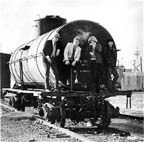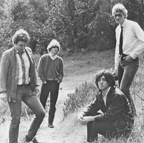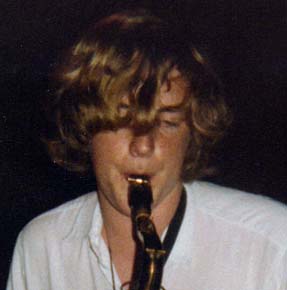1978-1984
(Ray Brandes offers the first comprehensive history of San Diego's original retro-visionaries. Excerpted from his book, Getting Nowhere Fast,)
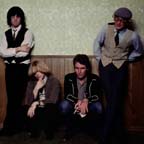 The Crawdaddys have been called one of the most influential bands ever to come out of San Diego. When one looks at the groups its members have spawned, as well as the recurring popularity of ‘60s-style punk and rhythm and blues over the past 30 years, it’s hard to dispute that assertion. Armed with an encyclopedic knowledge of music history, an uncompromising commitment to artistic integrity, and a roster of musicians with unparalleled talents and distinct individual styles, the Crawdaddys single-handedly gave birth to the revival of garage music in the late 1970s in the United States. The reverberations of the first few chords they played are still being felt today.
The Crawdaddys have been called one of the most influential bands ever to come out of San Diego. When one looks at the groups its members have spawned, as well as the recurring popularity of ‘60s-style punk and rhythm and blues over the past 30 years, it’s hard to dispute that assertion. Armed with an encyclopedic knowledge of music history, an uncompromising commitment to artistic integrity, and a roster of musicians with unparalleled talents and distinct individual styles, the Crawdaddys single-handedly gave birth to the revival of garage music in the late 1970s in the United States. The reverberations of the first few chords they played are still being felt today.
The Crawdaddys’ story begins and ends with lifelong Beatles fanatic Ron Silva, who grew up on Del Monte Avenue in Point Loma. He and his neighbor Steve Potterf started listening to records together in the ninth grade, and while Silva would barely tolerate Potterf’s love for Kiss, Aerosmith, Jethro Tull and Led Zeppelin, he gradually convinced his friend to appreciate his own tastes. “After a while Steve started getting into the music I liked -- Beatles, early Stones. I remember sitting in his room playing guitars along to my dad's Chuck Berry and Elvis Presley 45s,” says Silva.
Throughout high school, Silva, Potterf and Ron’s brother Russell spent many hours playing rock and roll in the Silva family garage, and it was during this period that Ron began his obsession with historical accuracy in clothing, shoes and hair, and in justifying what was considered cool as evidenced by a photograph in an album cover, an old magazine or book. He scoured his favorite albums for details, looking in thrift stores for similar clothing and traveling to Tijuana to purchase pointy-toed boots. He also developed a reputation as a bit of an oddball in high school for wearing Beatle suits and speaking in a Liverpudlian accent.
“In the final weeks of my last year at Point Loma High School, I knew that more than anything I wanted to get in a ‘real’ band,” Silva remembers. “I put an ad in the San Diego Reader that said that I was into the Kinks and Blondie!” The ad was answered by singer Jeff Scott (who had recently left the Dils) and drummer Josef Marc. “ I'd intended to start my own group but ended up joining Jeff’s and Josef's newly named Hitmakers. Jeff had a few originals, but when we started playing together we mostly covered songs by the Kinks, Beatles and early Stones.”The Hitmakers became part of a growing DIY scene in San Diego that included the Zeros and the Dils. It was reaching a zenith in 1977, when the three groups played a show at the Adams Avenue Theater in October. “I guess that was the first big ‘punk’ show in San Diego,” Silva says. “Unfortunately it wasn't a particularly majestic experience for me. I borrowed somebody's black Les Paul Gibson that night. A Les Paul is a pretty heavy guitar, and I'd never played one before. On our first song, I did one of my Pete Townsend jumps, and the strap broke, dropping the guitar like a ton of bricks!”
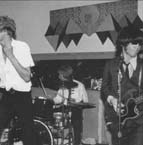 The Hitmakers eventually replaced their drummer with Joel Kmak, and Potterf joined the band on guitar. Their popularity grew -- not just locally, but in Los Angeles, Las Vegas and San Francisco, where the band planned to relocate at the end of the summer of 1978. On the eve of their departure, however, the Hitmakers decided to fire Potterf because they “didn't care much for his attitude,” according to Silva. “It probably took me about two days to decide that I would quit and start my own group. That was the Crawdaddys.”
The Hitmakers eventually replaced their drummer with Joel Kmak, and Potterf joined the band on guitar. Their popularity grew -- not just locally, but in Los Angeles, Las Vegas and San Francisco, where the band planned to relocate at the end of the summer of 1978. On the eve of their departure, however, the Hitmakers decided to fire Potterf because they “didn't care much for his attitude,” according to Silva. “It probably took me about two days to decide that I would quit and start my own group. That was the Crawdaddys.”
Birth of the Crawdaddys
The Crawdaddys came together quickly as Silva met Mark Zadarnowski through Tim LaMadrid, a fellow Beatles enthusiast who had been organizing home showings of rare Beatles films. “I was just beginning to try and learn how to play bass, and Ron was looking for something more authentically ‘60s than the Hitmakers,” recalls Zadarnowski. “Ron brought up the idea of starting the Crawdaddys. We knew [drummer] Dan [McLain] from his record store, Monty Rockers, and asked him to play drums.”The first gig was at Abbey Road in September, 1978, with Silva's brother (who was affectionately known as "Scuzz") on drums. Local musician and eventual Crawdaddy guitarist Joe Piper remembers the Crawdaddys’ second show at Glorietta Bay Hall in Coronado: “One day Dan McLain told me he'd joined an R&B band. My first thought was that he meant something along the lines of Jackie Wilson/Ike & Tina Turner Revue ... Shit! I don't know what I thought! But he was really excited about this band, ‘The Crawdaddys.’ And they blew my mind! I was amazed! There they were: this brave, beautiful, perfectly realized anachronism! In my own backyard! Who knew there was anyone in the world, much less San Diego, hip enough to do what they were doing!” The lineup of Silva, Potterf, Zadarnowski and McLain was in place by their third gig at the Lions' Club in North Park in January 1979.
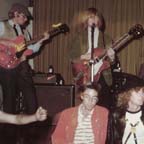 The Crawdaddys had now fully begun their assault on the eyes and ears of San Diego. Their next stroke of luck was aided by an unlikely source. “I got a call from Jeff Scott, who by then had forgiven me for quitting the Hitmakers,” recalls Silva. “He said he was going up to L.A. in a few days to play the Hitmakers' new demo for this guy Greg Shaw and if the Crawdaddys could put a few songs on tape he'd take me and Potterf along.”
The Crawdaddys had now fully begun their assault on the eyes and ears of San Diego. Their next stroke of luck was aided by an unlikely source. “I got a call from Jeff Scott, who by then had forgiven me for quitting the Hitmakers,” recalls Silva. “He said he was going up to L.A. in a few days to play the Hitmakers' new demo for this guy Greg Shaw and if the Crawdaddys could put a few songs on tape he'd take me and Potterf along.”
The band quickly assembled in the Silva garage and recorded Chuck Berry’s “Oh Baby Doll,” Bo Diddley’s “Tiger in Your Tank” and a couple of originals on a two-track machine. “In my opinion it would be fairly safe to say that Potterf and I blew Shaw's mind that day,” says Silva. “We walked in, and Potterf had this absolutely devout Brian Jones thing going with the hair, and we both had the complete Downliners Sect '64 look from head to toe. It was totally ridiculous and great at the same time. Shaw said, ‘Go back to San Diego and make an album, preferably for next to nothing, if you don't mind.’ We didn't.”
Watch the Crawdaddys play Bo Diddley’s “Cadillac”:
(It should be noted that the Crawdaddys' "Cadillac" video was not only their first recording, but also groundbreaking in concept. It was filmed as a project for a Communications class Zadarnowski was taking at UCSD. As Tim LaMadrid puts it, "Who else was doing music videos in 1978?")
Enter once again Tim LaMadrid, an unsung hero in the history of the Crawdaddys, whom Zadarnowski describes as “some sort of cross between George Martin and Mal Evans to us.” LaMadrid, who also took all of the original Crawdaddy photos, “provided untold schlepping, go-foring, driving and in general putting up with our crap for which he never received a penny,” says Zadarnowski. LaMadrid borrowed a four-track reel-to-reel tape recorder from the school at which he was working and recorded the entire album in a couple of days. Since the Crawdaddys’ legendary obsession with authenticity also applied to the equipment used to play and record the songs on the album, every sound needed to be justified by a musical recording of the era, and this of course meant no instruments manufactured after 1965, and no round-wound bass strings, nylon picks or synthetic drum heads. LaMadrid’s keen ear was exactly what the band needed. The Crawdaddys’ first album, “Crawdaddy Express,” released in 1979, served as a primer on ‘60s British rhythm and blues, circa 1964. Inspired by the Rolling Stones, the Pretty Things, the Kinks, Them, the Downliners Sect and the Animals, the group covered classics like John Lee Hooker’s “Let’s Make It,” Willie Dixon’s “Tiger in Your Tank” and Chuck Berry’s “Oh Baby Doll.”
The Crawdaddys play “Oh Baby Doll”: Listen now!
Cross Road Blues
While the Crawdaddys packed San Diego houses at the Roxy, the Adams Avenue Theater, the Skeleton Club and the North Park Lions Club as well as Los Angeles venues like Al’s Bar and Madame Wong’s, they were having to compete for both practice and playing time with two other successful San Diego bands with whom they shared members. McLain’s Penetrators were busy selling out Golden Hall and being courted by major record labels, and the Upbeats (Potterf’s project with Paris Trent) were growing disillusioned with San Diego and contemplating a move to Los Angeles.
Zadarnowski explains the resulting effects on the Crawdaddys: “I think Steve just got bored with the Crawdaddys as he got more into reggae, but you never really knew what he was thinking or feeling. In Dan's case, as the Penetrators became more and more popular it was simply harder for him to find time for the Crawdaddys. For him the choice was easy, as his goal from the beginning was to go as far as he could playing music, so the more successful band would obviously take priority.” Potterf left the group first and was replaced by 16-year-old Wunderkind Peter Miesner, whom Ron knew as a fellow Point Loman and Beatles fan. McLain left shortly thereafter, and after a brief period of floundering (and a stopgap replacement drummer nicknamed “the Eskimo”) was replaced by the Hitmakers’ Joel Kmak. For a very short while, the group featured also featured a harmonica player named Jeremy whose last name has been forgotten by everyone.
The Crawdaddys play “I’m Dissatisfied” from their EP “5 X 4”: Listen now!
Before the original Crawdaddys era ended, however, the band released two records that secured their reputation as the originators of the garage revival. Issued simultaneously by Bomp! in early 1980, the single “There She Goes Again”/”Why Don’t You Smile Now” and the EP “5 X 4” found the Crawdaddys at the height of their powers, their musicianship better than ever and Ron’s songwriting finally equal to those of his idols. These two records were a fitting final tribute to the Crawdaddys’ first era.
According to Mike Stax, who would later join the band as a bass player, “‘5 X 4’ is one of the greatest records from the post-’60s era. I think the original lineup was important, as they were one of the first bands to operate on such a purist level. Had they been able to maintain a stable lineup, pursued more original material, and continued to release records on the same level as ‘5 x 4,’ they would have been much more well-known today than they are.” Zadarnowski had this to say about the original Crawdaddys’ influence: “There is an article in which Peter Buck says that their version of ‘There She Goes Again’ was inspired by the Crawdaddys. Considering the impact on music that REM had, I think that’s enough right there. But I also think the Crawdaddys influenced other roots rockers in that we were the first to really try to duplicate the look and sound down to the letter with period amps and guitars as well as clothes and haircuts. When the Crawdaddys arrived, the other groups were more of a caricature of the ‘50s & ‘60s look and the music derivative rather than replicated. Later on it became de rigueur.”
For a brief period the Crawdaddys consisted of Ron Silva and Pete Miesner on guitars (with Pete playing the occasional saxophone); Mark Zadarnowski on bass; and Joel Kmak on drums. But an early 1980 interview in Dan McLain’s Snare magazine found the Crawdaddys (particularly drummer Kmak) frustrated with the paltry support from Bomp! and with the lack of local attention they were receiving: “That’s the thing about San Diego. Here you have a band that’s known worldwide—it’s been mentioned in trades throughout the world . . . I just don’t understand why a band with an album, EP and single out on a legit label doesn’t even get local press,” says Kmak in the interview. He left soon thereafter, creating a void behind the drums and initiating what would become a recurring problem for the band throughout the rest of its existence.
Silva switched to drums, and the Crawdaddys added keyboards courtesy of Keith Fisher, a brilliantly talented eccentric who had grown up with Peter and had also attended Point Loma High School. A saxophone player, Steve Horn, was added, but petty personality conflicts and internecine feuds between Fisher, Silva and Zadarnowski threatened to end the group and ultimately led to Zadarnowski’s ouster from the band in the summer of 1980. Guitarist Miesner surprised the rest of the Crawdaddys by quitting out of loyalty to Mark. Zadarnowski remembers: “I don't know what to say more than what a great guy Pete is. That he quit in protest when I got kicked out to this day impresses me and is a good example of Pete's integrity. He was still quite young then, and it would have been much easier for him to go alone with the group. Especially since we had very slim prospects of starting anything up ourselves.” Miesner and Zadarnowski tried for a while to start a band with Evasions guitarist Tim Griswold, but this project went nowhere without a drummer.
On the other side of the world, in a little village in West Yorkshire, England, 17-year-old Mike Stax was wearing out his copy of “Crawdaddy Express,” which he had bought on a trip to London after hearing “Oh Baby Doll” on John Peel’s radio show. Stuck in Bramham, halfway between Leeds and York, Stax had been learning to play the bass and unsuccessfully trying to start a ‘60s-style rhythm-and-blues band for months. “I think I must have written to the Crawdaddys through Bomp Records in the early summer of 1980,” Stax recalls. “Ron wrote back pretty quickly with the invitation to join the group. It took a few months to work out all the details and get enough money together to fly out to San Diego, and I arrived in the USA on November 3, 1980.”
Following Stax’s arrival, the Silva-Fisher-Horn-Stax lineup played several gigs. It’s difficult to imagine a band whose bread and butter is Chuck Berry and Bo Diddley lasting long without a guitarist, however, and it soon became apparent that they’d need to audition one soon.Joe Piper, longtime Crawdaddys friend and supporter and guitarist for the Decagents, remembers his audition with the group: “Somehow, I found myself at Keith's parents’ house for a practice, and (after proving that I really knew what it meant to ‘play like Ike Turner’ and promising I would never wear a short-sleeve shirt on stage) I was asked to join. They gave me a tape to take home to familiarize myself with the set list. We had one more rehearsal, and then it was full speed ahead! They wanted to play out as much as possible, and it seems like we did play a lot, even as we never rehearsed.”
Watch the Crawdaddys perform “Wade in the Water” at the Spirit Club in December 1980:
This so-called “Graham Bond Organization period” of the Crawdaddys lasted only a few months. Over the years the band had already developed a not-undeserved reputation for arrogance and cruelty towards outsiders, and once again the endless bickering amongst themselves began to cause problems. On the way to Los Angeles to play a show at Madame Wong’s, Piper informed the group that he was leaving: “I guess I left out of frustration. I'd always understood that The Crawdaddys were inherently self-limiting, but I'd really hoped that they were finally ready to deal with, maybe, actually achieving some sort of popular success outside of a very small scene of hipsters and cognoscenti. I really believed that incarnation of the band could have appealed to a much broader audience. And I wasn't at all concerned with how old the people who came to see us were, or how they were dressed or cut their hair. If they liked us, that made them cool.”
To read the rest of the Crawdaddys' story, purchase Getting Nowhere Fast, Ray Brandes' definitive account of San Diego's music underground from 1976 to 1986.
